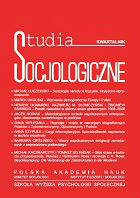Homogamia edukacyjna małżonków w krajach europejskich
Educational Homogamy of Spouses in European Countries
Author(s): Dariusz Przybysz, Henryk DomańskiSubject(s): Social Sciences
Published by: Instytut Filozofii i Socjologii Polskiej Akademii Nauk
Keywords: educational homogamy; marriage barriers; openness of social structure; cross-national studies; log-linear models
Summary/Abstract: Research on socioeconomic homogamy was developed by stratification researchers who used marriage patterns to describe how open stratification systems are. In cross-national studies primary concern of marriage homogamy lies in examination of similarities and differences in their social structures. Following large-scale international studies we use the European Social Survey data from 21 countries to examine the association between spouses’ educational levels. Loglinear analysis is applied to assess: (i) degree of association between education of spouses, (ii) patterns of barriers to intermarriage, (iii) variation in homogamy for partners with the same education for primary, uncompleted secondary, secondary, and university levels, (iv) asymmetry in marriage patterns between women and men. The strongest association between spouses’ education is in Italy, followed by Hungary, Poland, and Austria whereas the lowest association displays in the United Kingdom and Spain. Contrary to previous research we did not find inter-country variation in this association according to degree of modernization, cultural tradition, or division into post-communist and Western democracies. In line with all earlier studies we found – upon examination of parameters estimated for educational levels – an uniform tendency according to which the difficulties of intermarriage varies monotonically with differences between educational level of spouses. The tendency toward in-marriage proved to be the strongest in the lowest educational levels – such pattern takes place in the seventeen countries. Finally, our analysis substantiated presence of significant net gender gap but we find that it is by no means the same in each country.
Journal: Studia Socjologiczne
- Issue Year: 179/2005
- Issue No: 4
- Page Range: 69-98
- Page Count: 29
- Language: Polish

